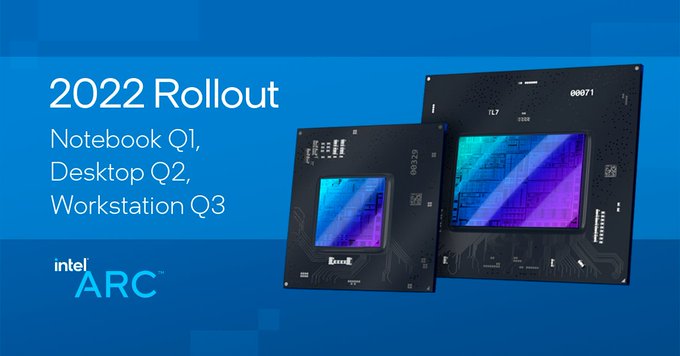Intel has provided updated roadmaps and details for upcoming products today, including GPUs and CPUs
Starting with GPUs:
* Intel ARC is slightly delayed, with desktop GPUs pushed back to a Q2 launch. Intel plans to manufacture 4 million desktop GPUs this year.
This 4 million figure is unlikely to inspire confidence, with Nvidia moving 10s of millions of Ampere GPU's, its a number from Intel that may not be able to provide significant downward pressure on GPU prices

https://cdn.wccftech.com/wp-content/uploads/2022/02/2022-02-17_22-20-53-1030x579.png
* Project Endgame: Intel will be launching a new service that allows gamers to access the power of an Intel Arc GPU. I don't know how well this will work, you play games on your PC, but all the graphics processing is done remotely in an Intel server housing an ARC GPU that you pay a fee to access.
* Intel Celestial architecture: Dominating the ultra high end market. Intel's next architecture is Battlemage, thats launching next year, but the year after in 2024 Intel is launching Celestial which it claims will take the ultra high end gaming performance crown.
- Intel is taking a slow stepped approach here - Alchemist is designed to compete with Nvidia and AMD 700 series GPUs (e.g 6700xt/RTX3070). Battlemage is designed to compete with 800 series GPUs (7800XT/RTX4080) and Celestial designed to beat 900 series GPU's (8900XT/RTX5090)
https://cdn.videocardz.com/1/2022/02/Intel-Roadmap.png
Foundry Updates
https://cdn.wccftech.com/wp-content/uploads/2022/02/2022-02-17_22-25-41-1030x579.png
CPU: In 2025 Intel will launch a new CPU architecture based on it's tiled MCM technology, it aims to be able to fit 5 chiplet/tiles on one die. These can be configured in a variety of ways, you can 5 chiplets of CPU cores, 2 CPU and 3 GPU or any other combination of CPU and GPU chiplets.
https://cdn.wccftech.com/wp-content/uploads/2022/02/2022-02-17_22-26-01-1480x833.png
Performance:
* Intel claims its Saphire Rapid SP chips are up to 150% faster than the just released AMD Milan-X, only shown one benchmark though (simulation of fluids)
https://cdn.wccftech.com/wp-content...U-vs-AMD-EPYC-Milan-X-Benchmarks-1030x579.png
* Intel claims its tiled Ponte Vecchio GPU is up to 260% faster than Nvidia in computing Black Scholes and Monte Carlo financial systems modelling
https://cdn.wccftech.com/wp-content...ecchio-GPU-vs-NVIDIA-Ampere-A100-1030x579.png
**Do Not Hotlink Images **
Starting with GPUs:
* Intel ARC is slightly delayed, with desktop GPUs pushed back to a Q2 launch. Intel plans to manufacture 4 million desktop GPUs this year.
This 4 million figure is unlikely to inspire confidence, with Nvidia moving 10s of millions of Ampere GPU's, its a number from Intel that may not be able to provide significant downward pressure on GPU prices

https://cdn.wccftech.com/wp-content/uploads/2022/02/2022-02-17_22-20-53-1030x579.png
* Project Endgame: Intel will be launching a new service that allows gamers to access the power of an Intel Arc GPU. I don't know how well this will work, you play games on your PC, but all the graphics processing is done remotely in an Intel server housing an ARC GPU that you pay a fee to access.
* Intel Celestial architecture: Dominating the ultra high end market. Intel's next architecture is Battlemage, thats launching next year, but the year after in 2024 Intel is launching Celestial which it claims will take the ultra high end gaming performance crown.
- Intel is taking a slow stepped approach here - Alchemist is designed to compete with Nvidia and AMD 700 series GPUs (e.g 6700xt/RTX3070). Battlemage is designed to compete with 800 series GPUs (7800XT/RTX4080) and Celestial designed to beat 900 series GPU's (8900XT/RTX5090)
https://cdn.videocardz.com/1/2022/02/Intel-Roadmap.png
Foundry Updates
- - Intel 4: Ready for mass production in 2022, delivers 20% increase in transistor density and performance per watt.
- - Intel 3: Ready for mass production in 2023, delivers further 18% improvement in density and perf/watt.
- - Intel 20a: Targeting 2024, delivers further 15% improvement in density and perf/watt
https://cdn.wccftech.com/wp-content/uploads/2022/02/2022-02-17_22-25-41-1030x579.png
CPU: In 2025 Intel will launch a new CPU architecture based on it's tiled MCM technology, it aims to be able to fit 5 chiplet/tiles on one die. These can be configured in a variety of ways, you can 5 chiplets of CPU cores, 2 CPU and 3 GPU or any other combination of CPU and GPU chiplets.
https://cdn.wccftech.com/wp-content/uploads/2022/02/2022-02-17_22-26-01-1480x833.png
Performance:
* Intel claims its Saphire Rapid SP chips are up to 150% faster than the just released AMD Milan-X, only shown one benchmark though (simulation of fluids)
https://cdn.wccftech.com/wp-content...U-vs-AMD-EPYC-Milan-X-Benchmarks-1030x579.png
* Intel claims its tiled Ponte Vecchio GPU is up to 260% faster than Nvidia in computing Black Scholes and Monte Carlo financial systems modelling
https://cdn.wccftech.com/wp-content...ecchio-GPU-vs-NVIDIA-Ampere-A100-1030x579.png
**Do Not Hotlink Images **
Last edited by a moderator:


